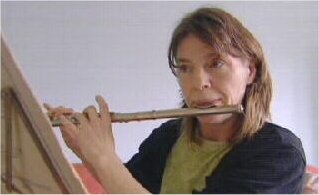Dystonia
Bodies out of Control
Dystonia – Extraordinary People
Channel Five continue their Extraordinary People series with "Bodies out of Control", a very apt title for the thought-provoking and disconcerting look at Dystonia.
Channel Five describe Dystonia as a rare condition, but there are thought to be 40,000 sufferers in the UK. Dystonia is thought to be caused by a malfunction in the part of the brain called the basal ganglia, this affects the way sensory signals are interpreted and motor signals are instigated. It causes the muscles to spasm involuntarily leading to twitching, shaking and the contorting of the face, neck and limbs is the most horrific fashion. Dystonia can cause the eyes to blink uncontrollably and even snap shut leaving the patient without sight. It can cramp the muscles of the larynx leaving the patient voiceless.
In the documentary we meet Valerie Cross, Janet Hunter, Joy, Martin and Amy Westall, Bridget Davies and Jacky Lewis, Ann Tonge and Daniel Rabone.
Each has their own story and each have their own way of dealing with this intrusive and debilitating condition.

Janet Hunter gains relief from Dystonia by playing the flute
Janet Hunter is a single mother of four who somehow manages to run a household and ensure her children are fed, clothed and sent to school each morning despite being unable to control her limbs and becoming exhausted after a few minutes work. She was, prior to dystonia, a brilliant linguist, speaking French, Arabic and Swahili amongst others. She has tried various treatments but none has worked. She consulted with a Dr. Choudhuri (pronounced Chowdra) who believes her condition is, at least in part, stress related. Janet has discovered that playing the flute allows her to focus her mind on reading the sheet music and playing the instrument. This allows the muscles to relax and gives some respite from the spasms. However, as soon as she stops playing the spasms return worse than ever.
Joy Westall succumbed to Dystonia at an early age. Her first signs of Dystonia began when she was just 9 years old. Despite this she went on to marry Martin her childhood sweetheart. After speaking with specialists and being assured that Dystonia was not hereditary, they decided to try for a family. In 1985 she had a baby girl, Amy, who was quite healthy. Sadly, this was not to stay. By the time Amy was eight years old, she like her mother began to show the initial tell-tale signs of dystonia. By the time Amy was eleven she had full, clear signs of dystonia. Ironically, about this time the specialists changed their position stating that Dystonia was hereditary and could be passed on through the genes.
In 2003 Joy and Amy learned of a revolutionary new operation being pioneered at National College Hospital in London. Known as Deep Brain Stimulation, this involved inserting 2 electrodes into the brain coupled to a battery pack located under the skin of the chest. This is a risky operation and, to date, less than 150 patients have undergone the procedure. Amy’s operation was a success, and almost immediately, her spasms stopped and the pain went. She is now swimming, taking dance classes and learning to drive. This operation had been reported here as being done at King’s College Hospital, however this was corrected after I was contacted by the administrator of www.parkinsonsappeal.com on behalf of Joy and Amy Westall.
Following Amy’s success Joy decided that she too would have the operation which, also, was a success and may mean that Joy will be able to put her foot flat on the ground for the first time in thirty years.

Bridget Davis & Jacky Lewis
Bridget Davis and Jacky Lewis became best of friends after meeting at a dystonia society meeting and discovering that they only lived a short distance apart. They both suffer from blepharospasm affecting the eye muscles. They often spend time walking where they take it in turns to be the other’s eyes. Bridget and Jacky have received botulinum toxin (Botox) injections around their eyes to ease the symptoms.
Ann Tonge had been a keen singer and a self-confessed chatterbox before the laryngeal dystonia reduced her ability to speak, let alone sing. She also receives regular Botox injections in her throat and this has restored her voice and she can sing again, albeit not as well as before.
Daniel Rabone also finds comfort in focussing the mind on a single task. He carries a full mug of liquid with him at all times as he finds this relaxes the muscle spasms in his shoulder. Daniel has had the Deep Brain Stimulation operation, but it did not work. Nevertheless he manages to remain good humoured and continues with his coffee cup.
Forms of Dystonia
Cervical Dystonia, Spasmodic Torticollic, Antecollis or Retrocollis. This form targets the neck area.
Blepharospasm affects the eye muscles.
Oromandibular Dystonia affects the mouth or jaw
Laryngeal Dystonia affects the throat or larynx
Segmental or Generalise Dystonia (dystonia muscolorum defoemans) affects many parts of the body
Some forms of dystonia may also be referred to as: Meige’s Syndrome, Breughel’s Syndrome or Segawa’s Disease.